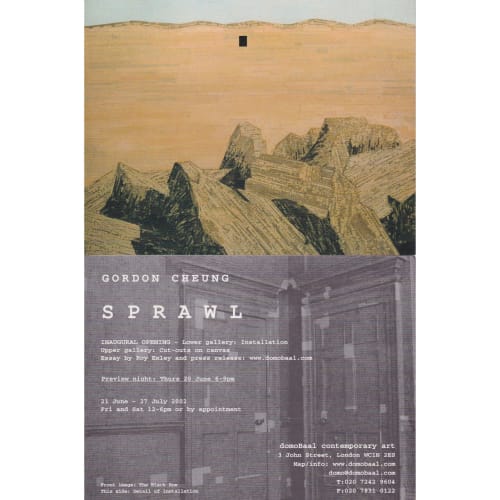Canyons, chasms, cliffs and crags all feature, like textbook examples of erosional landforms, in the recent works of Gordon Cheung. As if reflecting the dizzying ascents and precipitous falls of stock market trends, Cheung meticulously applies thousands of shredded strips of the Financial Times onto boards, to create images which are passable likenesses of rocky landscapes. Both bleak and raw, these images of pseudo-landscapes are visually teasing, are they blank computer graphics awaiting the endorsement of some hyper-violent game plan, or are they some sort of coded metaphor for the parlous state of the financial markets? The esoteric numbers codes and ciphers which are an integral part of the language of the stock market become even more obscured and mysticised as, in their jumbled juxtapositions, they tumble in stripes, waves and folds across the surface of Cheung’s images, before coalescing into their transmuted realities. Scales, both temporal and spatial are dramatically ruptured in this transformation process as our attention shifts from the ineffably slow rhythms of geomorphological change, which dissolve, as we look closer, into the transient and insubstantial nature of financial quantifiers. Our obsession for measurement and documentation is referenced in the realms of both the geologist and the stock-market dealer, of course, but their scales and rhythms are irrevocably divided. An intriguing analogy is suggested here which illuminates those contrasts between the tortuously slow and methodical working methods that Cheung meticulously employs to create these images, and the hyperactive button-punching and phone-babbling spontaneity of the stock market traders struggling to keep pace with the see-sawing trends whose digits flicker and flash all around them.
The rhythmic staccato of strips, slices and shreds of pink newsprint spilling across the surfaces of his images, creating vistas of pseudo-landscapes, offer enduring evidence of the tortuously slow process of their genesis, a striving for a faultless signification by Cheung, which he knows, ultimately, can only end in failure. He seems to be demonstrating here the futility of our obsession with reproduction, simulation and iconic possession. Repetition to an almost pathological degree here generates a sense of claustrophobia holding us, paradoxically, at a distance from the agoraphobia-inducing panoramas of barren inhospitable mountains, until our imagination is released, with a sense of relief, into their pseudo-pictorial wide open spaces. These mountains ring of the spirit of those intrepid mountaineering exploits of the 19th Century Edward Whymper in the Alps, stalwart in his tweeds, with his hemp ropes, rigid ladders and grappling hooks, defying gravity and death every route new and untrammelled by human foot, every move spontaneous and unrehearsed. That 19th Century spirit of exploration is now transformed into our urge to push further into cyberspace as we roam the digital frontiers, our itchy feet superceded by twitchy fingers. As William J. Mitchell writes in his book City of Bits, “Cyberspace is opening up and the rush to claim and settle it is on. We are entering an era of electronically extended bodies living at the intersection points of the physical and virtual worlds”. While acting as a metaphor, perhaps, for one of those intersection points, Cheung‚s labour-intensive crafted images seem to teeter on that edge, where the lure of cyberspace, cuts us off from our romantic fantasies of the sublime and vertiginous wilderness, on which our increasingly electronic consciousness turns its back. It is as if he is, in a symbolic way, attempting to reconcile that market-driven rift between man and the land, by literally bridging the chasms that have opened up between the primal and the digital, pictorially reducing the unthinkable complexity of electronic data banks to the timeless physical certitude of the Earth’s crust, and its forms.
Intriguing contradictions seem to cluster in and around Gordon Cheung‚s works as if challenging us to analyse, rationalise and classify them, while at the same time offering a pleated and tangled smokescreen to defy that very process. These images plough a wavering furrow between the representational and the metaphorical, they offer us glimpses and fragmentary traces of a hi-tech financial world which at the same time is both a dynamo for and a symptom of the digital revolution - through whose illusory veil we can discern seductive views of the awesome expanse of nature. As with the alternating duality of the Gestalt image, however, neither realm here is allowed to prevail, at any one moment we can perceive only one or the other, it’s a matter of either, or, its our choice, but never the twain, it seems, shall meet. In questioning certainty and denying the attainment of seamless completion or flawless simulation, Cheung seems here to be challenging the relevance of representation itself through its own flawed enactment.
Textual Topographies - By Roy Exley
May 2002

